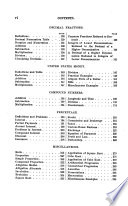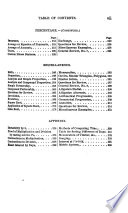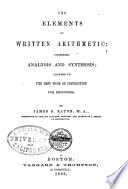 | James Stewart Eaton - 1862 - 320 pages
...number by which to divide. The QUOTIENT is the number of times the dividend contains the divisor. If the dividend does not contain the divisor an exact number of times, the part of the dividend which is left is called the REMAINDER. NOTE. The remainder is always of the same... | |
 | Robert Johnston (F.R.G.S.) - 1863 - 254 pages
...the dividend is to be divided, is called the Divisor ; and the result or answer the Quotient. When the dividend does not contain the divisor an exact number of times, there is a Remainder, which is always less than the divisor. DIVISION enables us to find the third... | |
 | James Stewart Eaton - Arithmetic - 1864 - 322 pages
...number by which to divide. The QUOTIENT is the number of times the dividend contains the divisor. If the dividend does not contain the divisor an exact number of times, the part of the dividend which is left is called the REMAINDER. NOTK. The remainder is always of the same... | |
 | George Augustus Walton - Arithmetic - 1864 - 364 pages
...in the quotient, and therefore take 17 (thousands) for our first partial dividend. We find also that the dividend does not contain the divisor an exact number of times, but that there is a remainder of 5. As this does not contain 7 any whole number of times, we can indicate... | |
 | George Augustus Walton - Arithmetic - 1864 - 376 pages
...m the quotient, and therefore take 17 (thousands) for our first partial dividend. We find also that the dividend does not contain the divisor an exact number of times, but that there is a remainder of 5. As this does not contain 7 any whole number of times, we can indicate... | |
 | John Fair Stoddard - Arithmetic - 1866 - 184 pages
...required part of the dividend; 4. The Remainder is the part of the dividend •which is left, when the dividend does not contain the divisor an exact number of times. The remainder ia always less than the divisor ? LESSON X.' I. ANALYSES, 8 .—8 are are as 8, which are... | |
 | Thomas Percy Hudson - Arithmetic - 1866 - 268 pages
...numbers means that the first is to be divided by the second. Thus 19-:-5 means 19 divided by 5. If the Dividend does not contain the Divisor an exact number of times, it will contain it a certain number of times (the Quotient), with a number left over, which will be... | |
 | John Fair Stoddard - Arithmetic - 1868 - 428 pages
...product ; in division, one of the factors and the product are given, to find the other factor. 4. When the dividend does not contain the divisor an exact number of, times, the part of the dividend which is left is called the Bemainder. Proof. — Multiply the divisor by the... | |
 | John Fair Stoddard - Arithmetic - 1888 - 480 pages
...the required part of the dividend ; 4 The Remainder, or the part of the dividend which is left, when the dividend does not contain the divisor an exact number of times. The remainder is always less than the divisor. 70. The Signs of Division are -~, — , and ). Thus, 20+4=5,... | |
 | James Stewart Eaton - Arithmetic - 1868 - 200 pages
...divide is the DIVISOR ; the number of times the dividend contains the divisor is the QUOTIENT ; and, if the dividend does not contain the divisor an exact number of times, i\&part of the dividend that is left is the REMAINDER. NOTE. The remainder, being apart of the dividend,... | |
| |